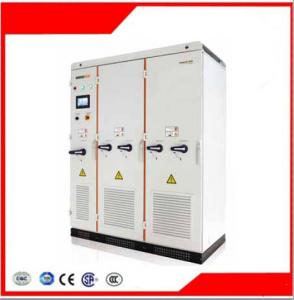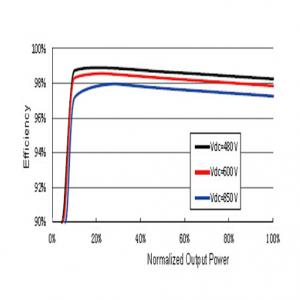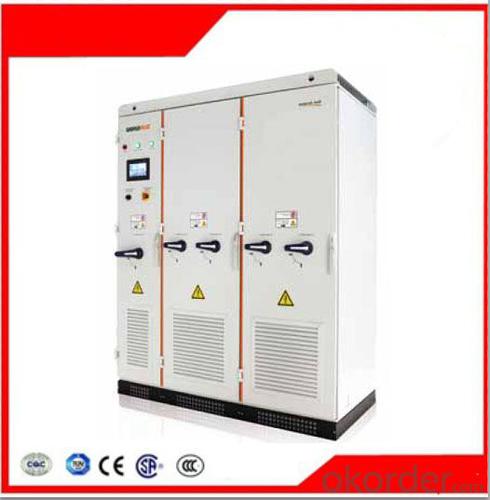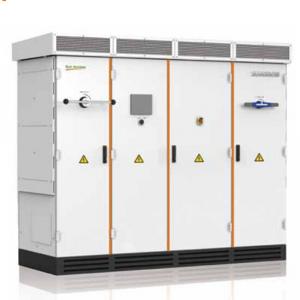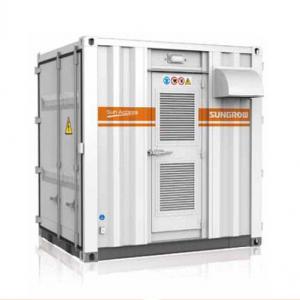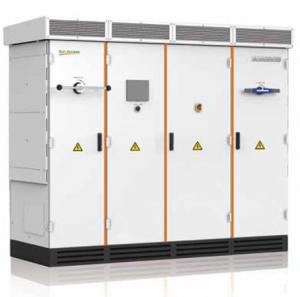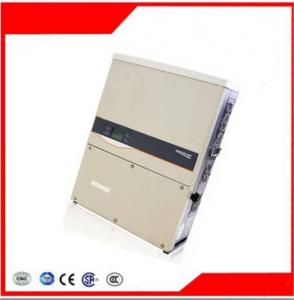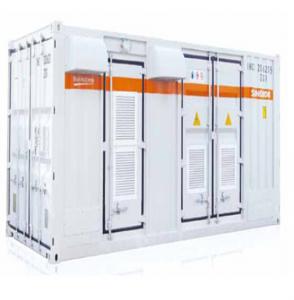Photovoltaic Grid-Connected Inverter SG500MX-M
- Loading Port:
- China Main Port
- Payment Terms:
- TT or LC
- Min Order Qty:
- 50 unit
- Supply Capability:
- 1000 unit/month
OKorder Service Pledge
OKorder Financial Service
You Might Also Like
1. Structure of Photovoltaic Grid-Connected Inverter SG500MX-M Description
A solar inverter, or PV inverter, or Solar converter, converts the variable direct current (DC) output of a photovoltaic (PV) solar panel into
autility frequency alternating current (AC) that can be fed into a commercial electrical grid or used by a local, off-grid electrical network.
It is acritical BOS–component in a photovoltaic system, allowing the use of ordinary AC-powered equipment. Solar inverters have
special functions adapted for use with photovoltaic arrays, including maximum power point tracking and anti-islanding protection.
Suitable for 50Hz/60Hz grid, could be used in Asia, North America and Europe.
2. Main Features of the Photovoltaic Grid-Connected Inverter SG500MX-M
• Advanced three-level circuit structure improves product's performance
• 4-MPPT, wide MPP voltage range
• Modular design, long operation time
• Film bus capacitors with long lifespan
• Rotating the modules in use extends the inverter's lifespan
• Inverter sleeping at night doubles the PCB lifespan
• Elevated cooling performance and protection level ensures reliable operation
• Less THD, more grid-friendly
• Less common-mode interference, more environment-friendly
• Compatible with two-winding transformer
• Flexible setting of 1 to 4 MPPT
• Reactive compensation on asymmetric power grid
• Direct parallel connection at low voltage side, easy to expand the capacity
• Comprehensive modular design
• All components front-maintenance
• Draw-type modules, service friendly design
• Less THD, more grid-friendly
• Less common-mode interference, more environment-friendly
• Compatible with two-winding transformer
• Flexible setting of 1 to 4 MPPT
• Reactive compensation on asymmetric power grid
• TÜV, CE, CGC certification, compliance with BDEW
3. Photovoltaic Grid-Connected Inverter SG500MX-M Images
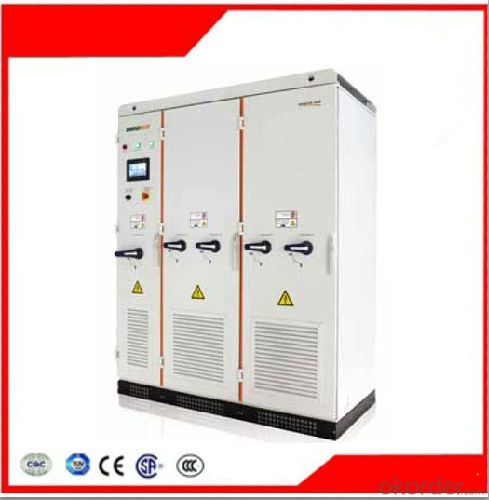
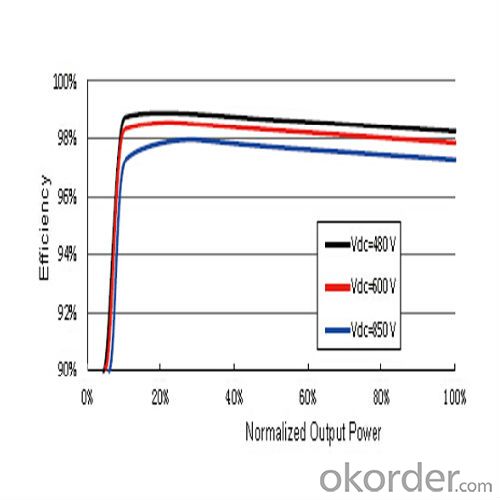
4. Photovoltaic Grid-Connected Inverter SG500MX-M Specification
Input Side Data |
|
Max. PV input power | 560kW |
Max. PV input voltage | 1000V |
Start voltage | 520V |
Min. operation voltage | 480V |
Max. PV input current | 1064A |
MPP voltage range | 480~850V |
No. of MPPTs | 1, 2, 3, 4 |
No. of DC inputs | 2 x 4 |
Output Side Data |
|
Nominal AC output power | 500kW |
Max. AC output apparent power | 550kVA |
Max. AC output current | 1018A |
THD | <3%(Nominal power) |
Nominal AC voltage | 315V |
AC voltage range | 252~362V |
Nominal grid frequency | 50/60Hz |
Grid frequency range | 47~52 / 57~62Hz |
Power factor | >0.99@default value at nominal power, adj. 0.9 overexcited~0.9 underexcited |
Isolated transformer | No |
DC current injection | <0.5 % In |
Efficiency |
|
Max. efficiency | 98.80% |
European efficiency | 98.60% |
Protection |
|
Input side disconnection device | DC load switch |
Output side disconnection device | AC load switch |
DC overvoltage protection | Yes |
AC overvoltage protection | Yes |
Grid monitoring | Yes |
Ground fault monitoring | Yes |
Overheat protection | Yes |
Insulation monitoring | Yes |
General Data |
|
Dimensions(W×H×D) | 1606×2034×860mm |
Weight | 1400kg |
Operating ambient temperature range | -30~+55℃ |
Night power consumption | <100W |
External auxiliary supply voltage | 220V, 8A |
Cooling method | Temperature controlled aircooling |
Ingress protection rating | IP21 |
Allowable relative humidity range | 0~95% no condensing |
Max. operating altitude | 6000m(>3000m derating) |
Fresh air consumption | 5575 m³/h |
Display | Touch screen LCD |
Communication | RS485/Modbus, Ethernet |
5. FAQ of Photovoltaic Grid-Connected Inverter SG500MX-M
Q1. What is the difference between inverter and solar inverter?
A1. Inverter only has AC inpput, but solar inverter both connect to AC input and solar panel, it saves more power.
Q2. What is the difference between MPPT&PWM?
A2. MPPT has higher efficiency, it can track the max power point and won't waste energy.
- Q: What is the role of a solar inverter in preventing system downtime?
- The role of a solar inverter in preventing system downtime is crucial as it converts the direct current (DC) generated by solar panels into alternating current (AC) that can be used to power electrical devices. By regulating and stabilizing the electrical output, a solar inverter ensures that the system remains operational and prevents any potential disruptions or downtime. Additionally, modern solar inverters often come equipped with advanced features like monitoring capabilities, which allow for real-time identification and troubleshooting of any issues, further minimizing the risk of system downtime.
- Q: After the PV inverter, how to achieve the same period before the network?
- Solar panel simulator: with MPPT function, simulated morning, noon, afternoon, evening, rainy weather, solar panels produced under different conditions in different voltages.
- Q: Can a solar inverter be used without solar panels?
- No, a solar inverter cannot be used without solar panels. The purpose of a solar inverter is to convert the direct current (DC) generated by solar panels into alternating current (AC) that can be used to power electrical devices in a home or building. Without solar panels producing DC electricity, there would be no input for the inverter to convert.
- Q: Can a solar inverter be used with different solar panel technologies?
- Yes, a solar inverter can be used with different solar panel technologies as long as the inverter is compatible with the specific voltage and power output of the panels. However, it is important to ensure that the inverter is designed to handle the specific characteristics and requirements of each solar panel technology for optimal performance and efficiency.
- Q: What is the lifespan of the capacitors in a solar inverter?
- The lifespan of capacitors in a solar inverter can vary depending on various factors, such as the quality of the components, operating conditions, and maintenance. Generally, high-quality capacitors can have a lifespan of around 10 to 15 years. However, it is important to regularly monitor and maintain the inverter to ensure optimal performance and longevity of the capacitors.
- Q: Grid-connected inverter is generally divided into photovoltaic power generation grid-connected inverter, wind power grid-connected inverter, power equipment and grid-connected inverter and other power generation equipment power generation inverter.
- The grid inverter is a current source, the output voltage is basically the grid voltage, may be slightly raised.
- Q: How does a solar inverter handle reactive power?
- A solar inverter handles reactive power by using power factor correction techniques. It actively manages the flow of reactive power between the solar panels and the grid, ensuring that the power factor remains close to unity. This helps to optimize the efficiency and performance of the solar system, while also maintaining the stability of the grid.
- Q: How does a solar inverter handle sudden changes in solar irradiance?
- A solar inverter handles sudden changes in solar irradiance by continuously monitoring the incoming solar energy and adjusting its output accordingly. When there is a sudden increase in solar irradiance, the inverter quickly ramps up its power output to match the new level of energy being generated. Similarly, if there is a sudden decrease in solar irradiance, the inverter rapidly decreases its output to prevent overloading. This dynamic response ensures optimal power generation and protects the system from potential damage due to irregular fluctuations in solar irradiance.
- Q: How does the input voltage range affect the performance of a solar inverter?
- The input voltage range directly affects the performance of a solar inverter. If the input voltage falls below the minimum range, the inverter may not be able to convert the DC power from the solar panels into usable AC power efficiently or at all. On the other hand, if the input voltage exceeds the maximum range, it can potentially damage the inverter. Therefore, it is crucial to ensure that the input voltage remains within the specified range for optimal performance and longevity of the solar inverter.
- Q: Can a solar inverter be used with a solar carport?
- Yes, a solar inverter can be used with a solar carport. A solar inverter is responsible for converting the direct current (DC) produced by the solar panels into usable alternating current (AC) electricity. This AC electricity can then be used to power various devices or fed back into the grid. In the case of a solar carport, the solar panels installed on the carport structure generate DC electricity, which is converted by the solar inverter into AC electricity to charge electric vehicles or power other electrical systems in the carport.
Send your message to us
Photovoltaic Grid-Connected Inverter SG500MX-M
- Loading Port:
- China Main Port
- Payment Terms:
- TT or LC
- Min Order Qty:
- 50 unit
- Supply Capability:
- 1000 unit/month
OKorder Service Pledge
OKorder Financial Service
Similar products
Hot products
Hot Searches
Related keywords
